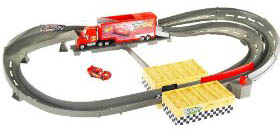Mack Track Challenge
Lightning McQueen from Cars changes lanes and jumps up Mac's ramp
 The action starts as Lightning McQueen boosts into high speed with the power booster. Next you can make a lane change by pushing and holding the button to make Lightning McQueen take the inside route. Mack is on the track to catch up in the race. If Lightning McQueen can zoom up Mack's loading ramp, he will jump right out of the top and onto the inner lane to take the lead. the playset includes one Lightning McQueen vehicle.
The action starts as Lightning McQueen boosts into high speed with the power booster. Next you can make a lane change by pushing and holding the button to make Lightning McQueen take the inside route. Mack is on the track to catch up in the race. If Lightning McQueen can zoom up Mack's loading ramp, he will jump right out of the top and onto the inner lane to take the lead. the playset includes one Lightning McQueen vehicle.
History of the Mack Truck
The history of the Mack Truck is a journey that spans over a century, showcasing innovation, durability, and a lasting impact on the world of transportation:
Early 20th Century: The Mack Truck Company, officially known as Mack Trucks, was founded in 1900 by brothers Jack and Augustus Mack. They started as a wagon-building business before transitioning to building motorized vehicles.
1905 - First Truck: Mack produced its first motorized vehicle, a 20-horsepower truck. This marked the company's entry into the truck manufacturing industry.
1910s - Military and Industrial Use: During World War I, Mack trucks were used for military transport. The company also played a crucial role in supplying trucks for construction and infrastructure projects.
1920s - Bulldog Symbol: The iconic Bulldog mascot became associated with Mack Trucks in the 1920s, symbolizing the toughness and durability of the vehicles.
1930s - Streamlining and Innovations: Mack introduced streamlined designs and technological innovations, such as the first enclosed cab and the development of air suspension.
1940s - World War II: Mack trucks were again utilized for military purposes during World War II, contributing to transportation and logistics efforts.
1950s - International Expansion: Mack Trucks expanded its reach internationally, establishing manufacturing and assembly operations in various countries.
1960s - Heavy-Duty Focus: Mack Trucks focused on producing heavy-duty trucks and became a leader in the construction and long-haul trucking sectors.
1970s - Energy Crisis: The oil crisis of the 1970s prompted a shift toward fuel-efficient models and the introduction of innovative technologies like the Maxidyne engine.
1980s - Technological Advancements: Mack continued to invest in technology, introducing computerized engine control systems and aerodynamic designs.
1990s - Volvo Acquisition: In 2000, the Volvo Group acquired Mack Trucks, forming a partnership that leveraged each company's strengths in the global commercial vehicle market.
2000s - Sustainability and Efficiency: Mack Trucks continued to prioritize environmental sustainability and fuel efficiency, introducing models with cleaner emissions and advanced engine technologies.
2010s - Electric and Autonomous Exploration: Mack explored electric and autonomous vehicle technologies, aligning with industry trends and addressing future transportation challenges.
Present and Beyond: Today, Mack Trucks remains a leading manufacturer of heavy-duty trucks, known for their ruggedness, reliability, and innovative features. The company continues to evolve and adapt to the changing landscape of transportation.
The history of the Mack Truck is a testament to the company's enduring commitment to quality, innovation, and its profound impact on the trucking industry, shaping the way goods are transported around the world.
